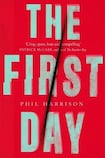
Samuel Orr is the pastor of a small mission hall in East Belfast. He is married, the father of three children. He falls in love with Anna, a 26-year-old Beckett scholar and poet, who lectures at Queen’s. They have an affair, she becomes pregnant. Various considerably less-predictable events occur as the novel unfolds and moves to its unpredictable but not unsatisfactory conclusion.
The story is set over a period of about 45 years. The main section, focusing on the affair, occurs between 2010 and 2016. Although dates are not mentioned, and the tone is not at all futuristic, the final section seems to be set about 2035. This final section is narrated in the first person by the person who, we discover, has actually been narrating the entire story until then, but in the third person – I don’t want to reveal who it is, since the revelation is one of the novel’s interesting surprise effects.
It’s a most unusual novel, which seems to be playing with our perspectives and assumptions about time. For instance, although it is set in more or less present day Belfast, the mood of that section seems very old fashioned. This may be the point: Samuel Orr, devoted to the Bible, is in a time warp. He is an emotional and moral extremist.
The relationship with Anna is conducted in utmost secrecy, until the moment when he decides to make a public announcement about it, with disastrous consequences. The early part of the novel is written in powerful poetic prose, and with the detailed analysis of emotion, the understanding of how body and mind interact, strongly reminiscent of DH Lawrence. Indeed I wondered if Anna were named after one of the main characters in that novel?
“The movement into motherhood, for Anna, was less like journeying into another country than like discovering in her own home a room she never knew existed, furnished already and comfortable. She noted that her senses changed, physically; her hearing became more acute, attuned to the sounds of her child’s cries and movements . . . As she grew accustomed to looking at him, the faces of others, of Orr himself, grew grotesque, ugly. They were outsized, the child’s face the new measure of everything.” (page 60)
Change of writing
Much more Lawrence than Beckett. The richness of the prose and the close analysis of feeling is not sustained for the entire novel. About half-way through, it becomes more of a thriller or mystery story than a deep psychological novel, and the writing changes correspondingly, becoming somewhat thinner.
However, it continues to engage. It’s a thoroughly readable, entertaining novel.
Some details challenge credibility and some readers may find this irritating. Anna’s stellar career – she has published her PhD by the time she is 26 – is taken completely for granted. During her maternity leave, she submits a number of papers to a conference in Barcelona. (Usually one is enough, even if you’re not on maternity leave.) The third section of the novel, in New York in 2036, is perhaps the most risky. The author has not bothered to depict the city as in any way different from right now. There are no attempts at futuristic fantasy. Instead everything is just as it is now – young Irish artistic types have residencies at small universities, people sit outside cafes drinking coffee and smoking. Sam even uses Facebook, and has a mobile phone. The author is to be commended for not bothering to invent gimmicks. In this case, by being realistic he is being unrealistic – Facebook won’t survive for 30 years, whatever about cafes and Irish artists, and New York. This refusal to engage with imagining a future as any different from now is, curiously, one of the novel’s most innovative aspects.
It is a wonderful debut, as the blurbs say. A fully engaging, well-written, very imaginative novel.












